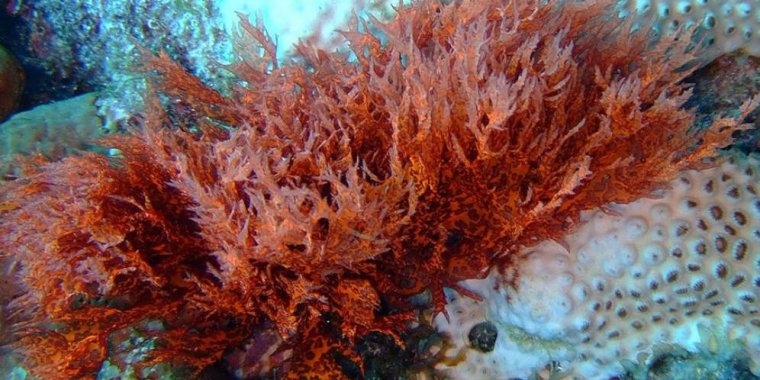| News / Science News |
Mimicked red algae enzyme used to boost crop yields
Australian scientists have discovered a way to engineer more efficient versions of the plant enzyme Rubisco by using a red algae-like Rubisco from a bacterium, which has the potential to improve production of crops like sorghum, wheat and rice in the Asia Pacific region and the world.

Rubisco from red algae has a different kind of mechanism that makes them more productive and efficient in photosynthesis. Photo: John Martin Davies
The research aims to improve the carbon-fixing process of photosynthesis to increase growth and yield of major crops.
Rubisco (Ribulose-1,5-bisphosphate carboxylase/oxygenase), the most abundant enzyme on earth, fixes carbon dioxide from the atmosphere into sugars and energy during photosynthesis. But its slow activity often limits the growth rate of plants.
However, Rubisco from red algae and Rhodobacter sphaeroides, a kind of purple bacterium that can obtain energy through photosynthesis, have different kinds of mechanism that makes them more productive and efficient.
“For this reason, we know the properties of the bacterial R. sphaeroides Rubisco can be moulded so that it functions more like red algae Rubisco, which fixes carbon dioxide more efficiently than the Rubisco found in crops.
Thus, it has the potential to improve the growth of crops like rice and wheat by as much as 30 per cent,” says Spencer Whitney, lead author and professor at the Australian National University’s ARC (Australian Research Council) Centre of Excellence for Translational Photosynthesis in Canberra.
Researchers used the bacterial red Rubisco, which unlike red algal Rubiscos, can function inside a plant. It is the first time that scientists have been able to produce functional red Rubisco in green plants.
“By supplying these plants with a complimentary Rubisco repair protein, we were able to make it function even better. We took advantage of the fact that bacterial Rubisco does not need special chaperone proteins to assemble in plants,” says Laura Gunn, co-author and now principal investigator at Uppsala University’s Department of Cell and Molecular Biology in Sweden.
“This enables us to use this red Rubisco as a protein scaffold for introducing regions of sequence from its red algal cousins to enhance carbon fixation efficiency, and thus plant growth,” Gunn tells.
As a result of the study, researchers can now test how well modified versions of the red-Rubisco can be produced in plants by first expressing it in Escherichia coli, a bacterium used in laboratory testing.
“We can now short-circuit the whole Rubisco-bioengineering experimental pipeline by first undertaking mutagenic directed evolution tests in E. coli, and then only transfer the “better” version(s) into plants for testing their effect of plant photosynthesis and growth. It speeds up engineering efforts more than100-fold because E. coli is a high-throughput testing system relative to plants,” says Whitney.
Researchers say that once more efficient red Rubisco variants have been engineered using their platform, it could be transferred to relevant crop species.
However, they caution that a limitation of their experimental approach is that it targets genetic modification of the small circular genome found in chloroplasts.
“While making changes to this genome prevents the chance of genetic outcrossing, the techniques for transforming chloroplast genomes are established in only a limited number of crops — such as canola, soybean, lettuce, carrots, potatoes and tomatoes.
Efforts are underway to extend the technology to key grain crops such as maize, rice and wheat, but their availability is still a few years away,” Whitney tells. (SciDev.Net)
YOU MAY ALSO LIKE





